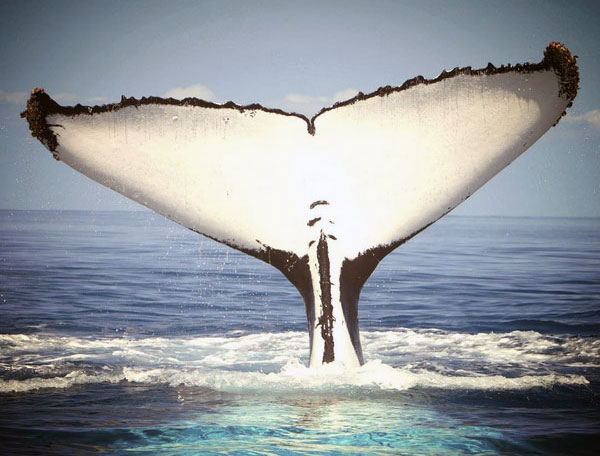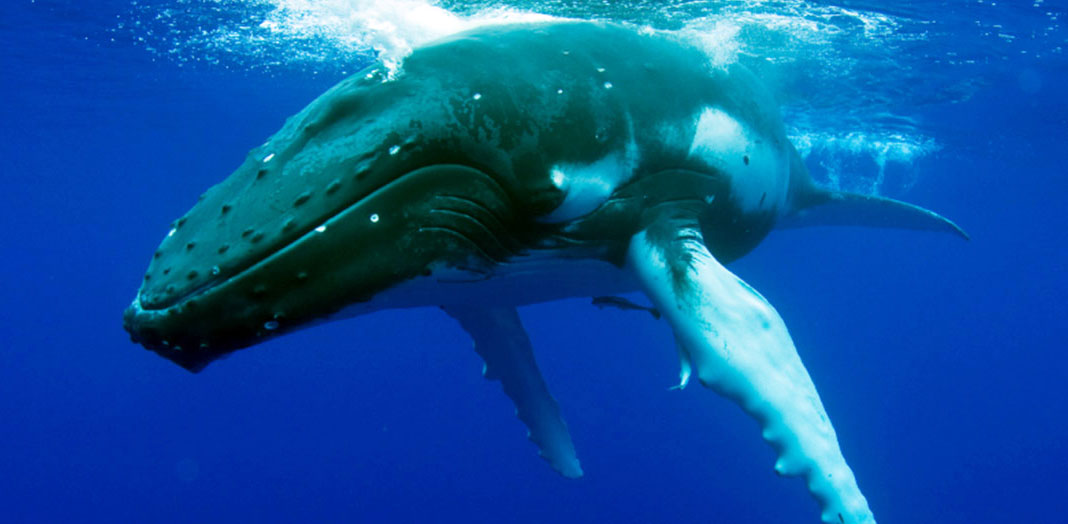Did You Know These Facts About Humpback Whales?

Humpback whales are enormous creatures — about the size of a school bus. They are known for their haunting and melodic songs and for breaching the water with amazing acrobatic abilities.
Humpbacks don’t normally have a hump on their backs; the name comes from the large hump that forms when they arch their backs before making a deep dive into the ocean. The scientific name, Megaptera novaeangliae, means “big-winged New Englander” because the population that swam off New England was the best known to Europeans, according to the National Oceanic and Atmospheric Administration (NOAA).
Humpback whales are not the biggest whales — that’s the blue whale. Humpbacks can grow to 60 feet (18 meters) long, and they can weigh a whopping 40 tons (about half the size of a blue whale), according to the NOAA. Their flippers can grow up to 16 feet (5 m) long, which is the largest appendage in the world. Their tails are also massive and grow up to 18 feet (5.5 m) wide. Like most whales, females are larger than males.

Humpbacks’ heads are broad and rounded and covered with knobs, called tubercles. Each knob contains at least one stiff hair, according to the American Cetacean Society (ACS). The purpose of the hairs is not known, but it is thought that they may be motion detectors.
Humpbacks are black on the upper (dorsal) side and mottled black and white on the under (ventral) side. Ventral pleats run from the tip of the lower jaw to the belly, according to the ACS. They have a dorsal fin on their backs. The shape and color pattern on the dorsal fin and flukes is unique to each individual, like human fingerprints. That discovery has helped researchers identify, catalog and monitor humpback whale migration, population size, sexual maturity and behavior patterns.
Humpbacks roam all over the world, but exactly where they may be found depends on the time of year. In the summer, many humpbacks spend their time in high-latitude feeding areas such of the Gulf of Alaska or the Gulf of Maine, according to the NOAA. During the winter, they swim to the warm waters closer to the Equator, around Hawaii, South America and Africa.
The exception is the humpbacks that live in the Arabian Sea. They stay there year-round, eating and mating all in the same area, according to the ACS.
Humpbacks often propel themselves above the water and then splash back down, according to National Geographic. This is called breaching. Some scientists think that they may do this to splash off parasites, but they may just do it because it’s fun.
They also slap the water with their tails or flippers, according to the NOAA. These behaviors may be used to communicate with one another. They may also be used to show dominance and health during mating season, according to Whale Facts.
Humpback whales are known for their haunting songs, which are complex sequences of moans, howls and cries that often continue for hours, according to National Geographic. Only male whales sing, so scientists think they are trying to attract potential mates.
A male may sing for hours, repeating the song several times. All males in a population sing the same song, but the songs of each population are different. For example, whales in the North Atlantic sing one song, while whales in the North Pacific sing another song, according to the NOAA. Songs gradually change from year to year.
Songs can be heard 20 miles (30 km) away, according to the NOAA. The whale sounds typically have an audio frequency between 80 and 4,000 hertz, according to National Geographic. In 2015, researchers reported hearing humpback vocalizations around 40 hertz. The low limit for human hearing is 20 hertz.
Humpback whales are baleen whales. Rather than teeth, they have 270 to 400 fringed overlapping plates hanging down from each side of the upper jaw, called baleen plates. The plates are made of keratin, which is the same thing human hair and nails are made of. Baleen plates are black and about 30 inches (76 cm) long, according to the NOAA.
Humpbacks mostly dine on small fish, krill (tiny crustaceans) and plankton. To eat prey, they take large gulps of water. Below the mouth are 12 to 36 throat grooves that expand to hold the water. The baleens filter the water, and the two blowholes on the whale’s back expel the water. The fish and other goodies remain in the whale for digestion.
These whales hunt and feed in the summer, and they will fast during mating season and live off the blubber reserves so they can focus on migration and mating, according to Whale Facts. A hunting method unique to humpbacks is called bubble netting. Humpbacks hunt in groups and use air bubbles to herd, corral or disorient fish. Humpbacks can eat up to 3,000 lbs. (1,360 kilograms) of food per day, according to the NOAA.
A female humpback has a baby every two to three years. She carries her young for a gestation period of about 12 months, according to the ACS. Babies, called calves, are born live, like most mammals. The newborns are between 10 and 15 feet (3 to 4.5 m) long and weigh up to a ton (907 kg).
The calves nurse for almost a year. Their mother’s milk is 45 to 60 percent fat content, according to the ACS. Calves can drink about 158 gallons (600 liters) of milk per day. Though they double their length in the first year, calves keep growing until they are 10 years old.
Humpbacks live around 50 years, according to the NOAA.
In Hawaii we are lucky and appreciative for our chance to see these beautiful mammals in our warm Hawaiian Waters!
See full article here : http://www.livescience.com/58464-humpback-whale-facts.html
NORTH SHORE SHARK ADVENTURES
Haleiwa Harbor
66-105 Haleiwa Rd
Haleiwa, HI 96712
Call 808.228.5900

